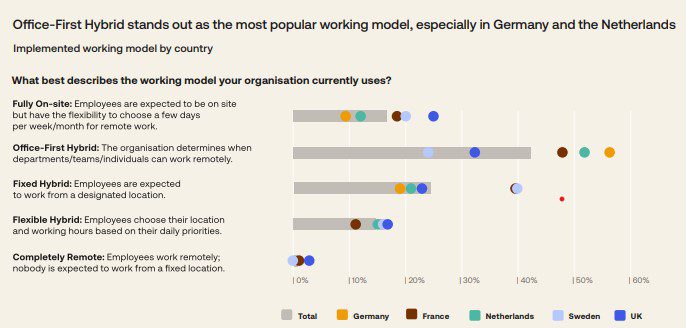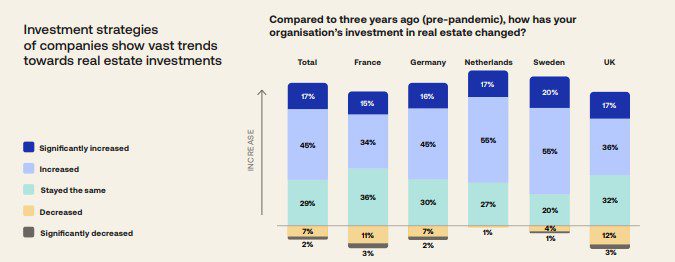Says Okta.
Hybrid is here to stay.
But there are numerous implementation challenges.
Okta's latest research suggests that organizations must focus on security to make hybrid a long-term success.
Hybrid is the current and future of work – this working model, where employees split their time between on-site and remote locations is here to stay.
Only 2% of European business leaders surveyed by Okta said they had no guidance for the future of work, while 43% said they gave workers the flexibility to choose a few days a week or a month to work from home.
The most common model, according to Okta’s survey of over 500 leaders in the UK, France, Germany, the Netherlands and Sweden, was an office-first hybrid model. This is where organizations determine when individuals or teams can work from home.

The Okta Hybrid Work Report 2023
Only 15% were allowing employees to choose their location and hours, and just 10% were allowing for fully remote work, according to Okta.
This is because organizations deem remote workers to be more productive (63%), but they still believe that in-person work has a role to play, particularly around collaboration.
This explains why there has been an increase in investment in business real estate since COVID-19, and particularly on reconfiguring workspaces to facilitate face-to-face collaboration.

The Okta Hybrid Work Report 2023.
Commenting on the findings, Okta’s head of industry solutions, EMEA, Ian Lowe tells UNLEASH: “We’ve seen lots of businesses, including the likes of Twitter, come out in favor of workers being physically in the office.
“It has felt like many business leaders have made a U-turn when it comes to remote or hybrid work, wanting workplace culture to go back to the way things were done pre-pandemic.
“Therefore, it was surprising to see that a significant majority of leaders do feel that workers are more or at least equally productive at home.”
Of course, hybrid work is not a simple solution. Every organization needs to figure out what model works best for them. While office-first hybrid might be the most common approach, that doesn’t mean it works for all organizations – some might want more fixed or more flexible options.
Okta therefore calls on employers to continue to review their hybrid working model. 75% of business leaders are on board with doing so within the next year, with 10% of those doing continual assessments.
Part of the review must be figuring out how to create an equitable experience no matter where employees work – a phenomenon known as proximity bias.
“It’s critical leaders do not blindly implement ways of working, without consideration of ways to mitigate things like proximity-bias, incohesive workplace culture and negative employee experiences”, notes Lowe.
The good news it that leaders are aware of the need to nip proximity bias in the bud – almost three in four are ensuring that remote workers are not disadvantaged and 42% are actively investing to prevent it.
To help here, employers need to provide top-notch technology that makes it possible for employees to work productively both on-site and from home.
This requires full C-Suite support, and for teams like IT, finance, operations and HR to collaborate with one another, according to Okta’s report.
There has been a lot of discussion about balancing employee’s preferences around working model and business needs.
The latter is usually talked about in financial outcomes (and within the lens of productivity and successful collaboration), but Okta’s report also looks at another element of this balancing act: cybersecurity.
Okta’s research found that improving cybersecurity was the biggest challenge that employers face around hybrid work – it is also the number one priority.
The issue is that with hybrid work “both humans and their devices are now spending most of their time outside the traditional corporate security perimeter”, according to Okta’s research. And this brings heightened security risks.
The added challenge is maintaining “a balance between security and user experience as they architect remote and in-person work environments that put resiliency and trust at the fore”, stated the report.
So, what is the solution? Okta’s report concluded: “Yesterday’s office-based business processes weren’t designed to maximize the productivity of remote teams, and legacy, perimeter-based security strategies are largely inadequate for today’s flexible and distributed workforce.
“Today’s organizations need to adopt a Zero Trust model, focusing on identity as the new perimeter. Strong authentication for all services – from on-premises applications to cloud and mobile – and users is a must-have in this world.”
If this article caught your interest, you can find more like it on cybersecurity. Enjoy!
Get the Editor’s picks of the week delivered straight to your inbox!


Chief Reporter
Allie is an award-winning business journalist and can be reached at alexandra@unleash.ai.
"*" indicates required fields
"*" indicates required fields